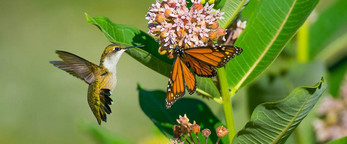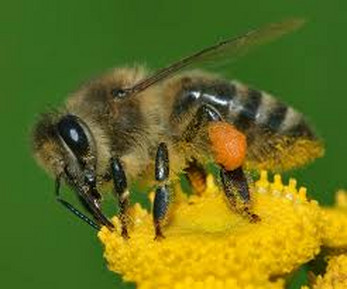“Pollinator Panic” Schematic
A downloadable game
Players: 4 players
Type of Game: Digital Game
Introduction: In this game, players are given a choice to play one of four pollinators of their choosing (honeybee, bumblebee, hummingbird, butterfly). These are pieces that move around the board. The goal of the game is for the players to collect as many flowers as possible as they move around the board until 12 rounds of the game are completed.
Pollinator Panic is a party game stylized as a board game. At the start of the game, the players play a minigame. There are multiple minigames available, but one will be chosen randomly.
Minigames:
A mini-game could consist of apples falling from a tree. The players are on the ground and they move side to side to catch as many apples as possible. Bright red apples add one point, moldy apples subtract one point, and golden apples are plus five points. (time limited)
The four players dodge raindrops to reach the finish line. If the player gets hit with more than 3 raindrops, they are eliminated from the minigame. There are potentially a minimum of 15 minigames, although more can be created (these will be determined).
Players must collect as much pollen as possible which is blowing around frantically in the wind. Collecting pollen adds 1 point, golden pollen is five points, and if a player hits debris, they lose 1 point. (time limited)
Players must dodge a hawk trying to eat them from above. Players only get one life in this game. Whoever survives the longest wins.
A simple puzzle game where players twist the remote around the match the puzzle pieces together. Whoever finishes their puzzle first before the timer wins. (time limited)
A tetris-like minigame where players have to connect matching honeycombs together. However, gets the most combinations before the timer wins.
A game where you have to imitate dance moves from a Queen Bee-like character. If the player ever makes an error in imitating the moves, they are eliminated from the game. Whoever is the last one standing wins.
A maze game where players must escape a maze. Whoever escapes the maze the first wins.
Players knock each other off with a tree branch with sticks. Whoever is the last standing on the tree branch wins.
A swarm of bees flies past the players and the players have to guess how many bees are in the swarm. Whoever guesses closest to the actual amount wins the game.
A gun shooter where players must shoot hornets in order to gain points. If players accidentally shoot bees they lose points. Whoever shoots the most hornets before the timer wins the game.
A matching game where players must match pairs of cards together. Each player takes a turn at drawing cards and the player that gets to go first is chosen randomly. Whoever gets the most matches wins the game.
Players
The minigames determine how many pollen balls (the currency players can use to purchase flowers) and cards each player is given. There is a minigame at the beginning of each round. The player who wins first place gets 10 pollen balls, second place gets 5 pollen balls, third place gets 3 pollen balls, and the player in last place gets 1 pollen ball.
After the minigame is played, the players can move around the board. The player in first place goes first, second place goes second, etc.
The cards of the game serve as dice, determining how far the players can progress on the board by a number that is indicated on the card. Players in first place win 6 cards. Players in second place win 5 cards. Players in third place win 4 cards and players in fourth place win 3 cards.
On each player's round, the players can use 2 of their cards. This means that the player in first place has a higher chance of picking a more valuable card than the player in last place who has limited cards to choose from. Since the card has a different value that determines how far the players can move, the use of cards rather than dice to determine movement around the board allows for significant variation in the card value and distribution. Special high-value cards and ability cards be mixed in with the more mundane movement cards. During playtesting different card variants can be evaluated.
A Sample Deck-
Common Cards- “Move One Space”- 50 cards, “Move Two Spaces”- 25 cards, “Move Three Spaces”- 15 cards, “Move Four Spaces” - 10 cards, “Move Five Spaces”- 5 cards,
Special Cards- 1 copy each:
- “Move Ten Spaces”
- “Switch places”- allows players to switch places with any player they chose,
- “Draw another card”- allows players to pick an additional card from the deck
- “Card thief”- steal one card from a random player's deck,
- “Tornado”- moves a chosen player back several spaces
- “Pollen thief”- steal a random amount of pollen from someone else
- “Tele” and “Port”- the player must have both of these cards in order to teleport wherever they want
At the end of each round, players must return their cards to the main deck.
On certain spaces, players can also use pollen balls to purchase “special cards” as well. These cards can be kept by the player and used as needed. However, the strategy here is that players must use their pollen balls wisely as they will need to save up enough pollen balls to purchase a flower at certain spaces on the game board.
When players land on a flower space, they can purchase the flower based on the pollen ball value of the designated flower (each type of flower has a different pollen ball value).
As players move around the board, spaces serve to either help the player advance or hinder them. The players start the game at a starting point and move around the oval track. The board is expected to have 40 spaces. The computer will randomly assign each space a tile prior to the game starting. There will be spaces that make the players advance higher on the board (like finding a meadow) or go several spaces back (they have to fly away from a hawk or some other predator). There are also spaces where the players can exchange pollen balls for special cards, as well as spaces where players gain or lose a certain amount of pollen balls. Perhaps the most important spaces are the ones where players can exchange pollen balls for flowers. Players need to save up their pollen for these spaces because if they don’t have enough pollen to buy the flower they can’t go back to that space at any other point.
When you complete a lap, you acquire 10 pollen balls.
Space tiles, one per space:
- 15 blank spaces
- 4 flower spaces
- Meadow space (player moves forward 5 spaces) (5 spaces)
- Predator space (player moves back 5 spaces) (2 spaces)
- Pesticide (1 space) (skip your next turn)
- 5+ pollen space (gain 5 pollen balls) (3 spaces)
- 5- pollen space (lose 5 pollen balls) (3 spaces)
- 10+ pollen space (gain 10 pollen balls) (2 spaces)
- 10- pollen space (lose 10 pollen balls) (2 spaces)
- Card shop space (3 spaces) (there will be 3 cards sold at these spaces. The cards generated at these spaces will be completely random. They each cost 5 pollen balls).
After 12 rounds, whoever has the most flowers with respect to the value that is calculated in pollen balls wins. If it’s a tie, the winner is determined by a final round of a random minigame.
| Status | In development |
| Author | boopidydoo |


Leave a comment
Log in with itch.io to leave a comment.